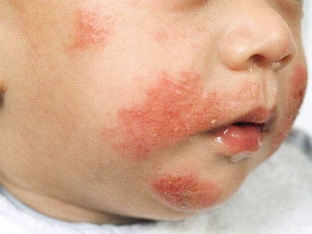Patients with atopic dermatitis are seen not only by dermatologists, but also by doctors of other specialties, since its manifestations are often associated with diseases of the digestive, respiratory, excretory systems, with viral infections, and metabolic disorders. At the same time, cases of overdiagnosis are not uncommon, when the diagnosis of atopic dermatitis is made with completely different skin diseases. Diagnostic difficulties are associated with a large number of different eczematous skin lesions with which it has to be differentiated. What are the difficulties in diagnosing atopic dermatitis in children?
Difficulties in diagnosing atopic dermatitis in children
Among the patients who visit a pediatric dermatologist, patients with atopic dermatitis account for approximately 37.12%. In the process of diagnosing atopic dermatitis in children, the number of diagnostic errors was 25.14%, and almost half of them were in the group of infants and young children. What errors in the diagnosis of atopic dermatitis in children can be, read further on estet-portal.com. Cases are not excluded when the doctor can "view" atopic dermatitis, especially mild forms, but overdiagnosis errors predominate at present.
In the process of diagnosis, instead of erroneously diagnosed atopic dermatitis, young children were found to have:
- neonatal or infantile acne, seborrheic dermatitis infantum (against the background of neonatal hormonal crisis), miliaria erythematosus, vesiculopustulosis, impetigo, diaper dermatitis, intertriginous streptoderma, limited skin candidiasis, scabies;
- in children aged II age-related phase of atopic dermatitis — lichen pilaris, erythematosquamous streptoderma, scabies, nummular eczema, autosomal dominant ichthyosis vulgaris with secondary infection, dyshidrotic eczema, strophulus, candidiasis of smooth skin and nail folds;
- in adolescents and older patients, lichen rosea, contact irritant or allergic dermatitis (metal dermatitis, cosmetic dermatitis), follicular keratosis against the background of juvenile pituitary dysfunctions, seborrheic dermatitis, microbial eczema.

The causes of diagnostic errors are varied. These include the objective difficulties associated with the lack of a single pathognomonic specific sign that would put an end to the diagnosis of atopic dermatitis in children, as well as with a large number of etiologically different eczematous skin lesions with which it has to be differentiated.
The causes of errors in the diagnosis of atopic dermatitis in children are associated with:
- a large number of different inflammatory, vesicular, exudative skin rashes in infants;
- unclear indications in the anamnesis about the exact date of the onset of symptoms and about the heredity of the child;
- the impossibility of assessing the subjective sensations of the infant (itching or burning, pain);
- the absence of a number of diagnostic criteria that have not yet manifested at the very beginning of the disease (chronic relapsing course, many additional criteria), and the low specificity of other signs (debut in early childhood,
- itching).
It is not uncommon for atopic dermatitis to be diagnosed in the absence of such an obligatory symptom as itching (in children with hair lichen), or when it debuts in adulthood.Also, in the complete absence of eczematous or lichenified lesions in children with other dermatoses, only on the basis of the words of parents about ”
food allergies” diagnosed with atopic dermatitis.
When diagnosing atopic dermatitis in children, the following signs exclude this diagnosis:
- no itching;
- no typical eczematous rash;
- debut at birth or in the first weeks of life.
Atopic dermatitis may be confused with any previous skin disease (erythema toxic neonatal, infantile seborrheic dermatitis,Also, when diagnosing atopic dermatitis in children, it is possible to establish an erroneous diagnosis in congenital infections with vesicular rash, in Ritter's disease, SSS syndrome, early microbial and eczema-like skin lesions in congenital immunodeficiencies.Lyell's disease, vesiculopustulosis).
Signs of eczema in the diagnosis of atopic dermatitis in children
With non-atopic eczema, lichenification can also form, sometimes a folded arrangement of the affected areas is also possible (with mycogenic and occupational eczema). There are still clinical differences between different eczematous diseases.
The most striking difference between atopic eczema is the special symmetrical localization of the rashes and its age-related changes:
- in infancy, symmetrical foci in the zone of blush on the face, vesicular rash on the outer surface of the legs, lesions on the extensor surfaces of the hands, on the head;
- in the II age phase, mainly fold and flexor localization on the limbs,
- in phase III, the upper body is mainly affected, especially the face, neck, hands.







Add a comment